Definition 3.3.1. (a) A mono (or subobject)
is called a fraction
if it is coflat and normal.
(b) A map to an object X is called generic
if it is not disjoint with any non-initial analytic subobject of X.
Proposition 3.3.2. (a) The class of
fractions is closed under composition and stable under pullback.
(b) If f: Y --> X is a fraction and U is a strong
subobject of Y, then U --> f+1(U) is a
fraction.
(c) If f: Y --> X is a fraction which factors through
a mono u: U --> X in a map v: Y --> U, then
v is a fraction.
(d) Any proper fraction of an object is disjoint with a non-initial
strong subobject.
Proof. (a) The classes of coflat maps and normal monos are closed
under composition and stable under pullback.
(b) Since f is coflat, we have f-1f+1(U)
= U by (1.5.4). Thus U --> f+1(U)
is the pullback of f along u: f+1(U)
--> X, therefore is a fraction by (a).
(c) The mono v is the pullback of f along u, thus
is fractional by (a).
(d) Suppose U is a proper fraction of an object X. Since
U is normal, U is disjoint with a non-initial map t:
T --> X, and we may assume t is a strong mono by (1.5.2).
––
Definition 3.3.3. (a) A map to an object
X is called local
if it is not disjoint with any non-initial strong subobject of X;
a non-initial object is called pseudo-simple
if any non-initial map to it is local.
(c) A map to an object X is called quasi-local
if it does not factor through any proper fraction to X; a non-initial
object is called quasi-simple
if any non-initial map to it is quasi-local.
(d) A map to an object X is called prelocal
if it does not factor through any proper analytic mono to X; a non-initial
object is called presimple
if any non-initial map to it is prelocal.
Proposition 3.3.4. (a) Any local map
is quasi-local; any quasi-local map is prelocal.
(b) The class of local (resp. generic, resp. quasi-local, resp. prelocal)
maps is closed under composition.
(c) A quasi-local fraction (resp. prelocal analytic mono) is an isomorphism.
(d) If f: Y --> X and g: Z --> Y are two
maps and gf is local (resp. generic, resp. quasi-local, resp. prelocal)
then f is local (resp. generic, resp. quasi-local, resp. prelocal).
(e) Any unipotent map is both local and generic.
(f) Any epi is generic.
(g) If f: Y --> X is a generic map and Y is quasi-primary
then X is quasi-primary.
Proof. (a) Any proper fraction u: U --> X is disjoint
with a non-initial strong subobject V of X by (3.3.2.d).
Any local map f: Y --> X is not disjoint with V, therefore
f does not factor through any proper fraction U. The second
assertion is trivial.
(b) Consider two local maps f: Y --> X and g:
Z --> Y. Suppose fg is disjoint with a strong mono v:
V --> X. Then f-1(V) -->
Y is disjoint with g: Since g: Z -->
Y is local this implies that f-1(V) is initial.
Thus f is disjoint with V. Since f is local, V
is initial. This shows that fg is local. The proof for generic maps
is similar.
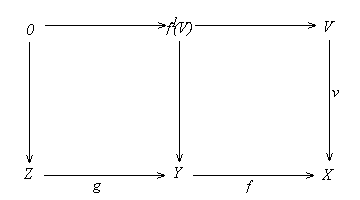
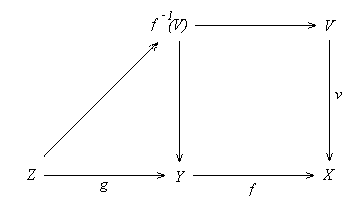
(f) If f: Y --> X is an epi then its pullback along any non-initial analytic mono V --> X is a non-initial epi W --> V, thus f is not disjoint with V --> X. Hence f is generic.
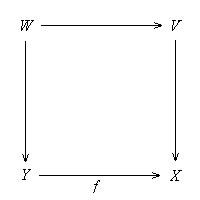
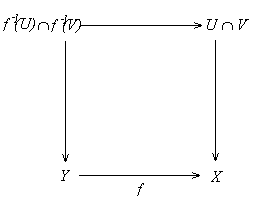
Recall that an epi e is called extremal provided that it does not factors through a proper mono. Every regular epi is an extremal epi.
Definition 3.3.5. A non-initial object is called simple (resp. extremal simple, resp. unisimple) if any non-initial map to it is epic (resp. extremal epic, resp. unipotent).
Proposition 3.3.6. An object X is simple (resp. extremal simple, resp. unisimple, resp. quasi-simple, resp. presimple) iff it has exactly two strong subobjects (resp. subobjects, resp. normal sieves, resp. fractions, resp. analytic subobjects).
Proof. A non-initial strong subobject V of a simple object
is determined by an epic strong mono, which must be an isomorphism by (1.1.2.b),
thus V = X. Conversely, assume X has exactly two strong subobjects;
then X is non-initial. If t: T --> X is any non-initial
map then t+1(T) is a non-initial strong subobject
of X, thus t+1(T) = X, so t
is epic.
A non-initial subobject V of an extremal simple object X
is an extremal epic mono, so V = X. Conversely if X has exactly
two subobjects, any non-initial map t: T --> X must be extremal
epic.
Any non-initial map to a unisimple object is unipotent, thus generates
the maximal normal sieve. This implies that X has exactly two normal
sieves. Conversely if X has exactly two normal sieves, any non-initial
map to X generates the maximal normal sieve, thus it is unipotent.
A non-initial fraction to a quasi--simple object is a quasi-local fraction,
thus is an isomorphism by (3.3.4.c). Conversely, if
X has exactly two fractions then any non-initial map is quasi-local,
so it is quasi-simple. The proof for the case of presimple objects is similar.
Proposition 3.3.7. (a) Any simple object
is integral.
(b) Any extremal simple object and any reduced unisimple object is
simple.
Proof. (a) Any simple object is reduced and primary (cf (3.3.6),
(3.1.2.a) and (3.2.1.a)).
(b) Clearly any extremal simple object is simple by (3.3.6).
Any non-initial map f to an object X is unipotent if X
is unisimple, and is epic if furthermore X is reduced. Thus any
reduced unisimple object is simple.
Proposition 3.3.8. (a) A non-initial
object is pseudo-simple iff any non-initial strong subobject is unipotent.
(b) Any simple object, extremal simple object, and unisimple object
is pseudo-simple.
(c) Any pseudo-simple object is quasi-simple.
(d) Any quasi-simple object is presimple.
(e) Any presimple object is primary.
Proof. (a) By definition a non-initial object X is quasi-simple
iff any non-initial map to it is not disjoint from any non-initial strong
mono. This implies that any non-initial strong mono is unipotent.
(b) Any non-initial strong mono to a simple or extremal simple object
is an isomorphism. Any non-initial strong mono to a unisimple object is
unipotent. By (a) these objects are pseudo-simple.
(c) and (d) follow from (3.3.4.a)
(e) Any non-initial analytic mono to a presimple object is an isomorphism,
thus any presimple object is primary.
Proposition 3.3.9. (a) Any reduced pseudo-simple
object is simple.
(b) Any non-initial strong subobject of a pseudo-simple object is pseudo-simple.
(c) The radical of any
pseudo-simple object is simple.
Proof. (a) Suppose X is a reduced pseudo-simple object.
By (3.3.8.a) any non-initial strong mono to X
is unipotent, therefore is epic, thus is an isomorphism. It follows that
X is simple by (3.3.6).
(b) Suppose V is a non-initial strong subobject of a pseudo-simple
object X . Then any non-initial strong subobject W of V
is also a strong subobject of X , thus W is a unipotent subobject
of X. It follows that W is also a unipotent subobject of
V. Thus V is pseudo-simple by (3.3.8.a).
(c) follows from (a) and (b).
Proposition 3.3.10. Suppose A
is locally
disjunctable in which each object has a radical. The following are
equivalent for an object X :
(a) X is pseudo-simple.
(b) X is quasi-simple.
(c) X is presimple.
(d) The radical of X is simple.
Proof. (a) implies (b) and (b) implies (c) by (3.3.8). Assume X is presimple. Any proper strong subobject V of its radical rad(X) is not unipotent in X, thus it is disjoint with a non-initial analytic mono u: U --> X to X by (3.1.10). Since X is presimple, U = X by (3.3.6). Thus V is initial. This shows that rad(X) is simple. Thus (c) implies (d). Finally assume X is an object whose radical rad(X) is simple. We prove that it is pseudo-simple. Suppose V is a non-initial strong subobject of X. Its radical rad(V) is a non-initial strong subobject of rad(X), therefore we have rad(V) = rad(X) as by assumption rad(X) is simple. Since rad(X) is unipotent, V is unipotent. Thus X is pseudo-simple by (3.3.8.a).
Proposition 3.3.11. Suppose any coflat
unipotent map in A is regular epic and any
map to a simple object is coflat. Then
(a) Any coflat mono is normal.
(b) Any simple object is extremal simple and unisimple.
Proof. (a) Consider a coflat mono u: U --> X. To see that u is normal it suffices to prove that any pullback of u is not proper unipotent. Consider the pullback v: V --> Y of u along a map f: Y --> X. If v is unipotent then the coflat unipotent mono v is a regular epi by assumption, so is an isomorphism because any regular epic mono is isomorphic.
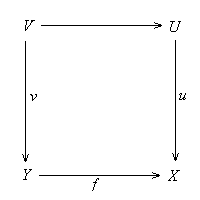
Example 3.3.11.1. The category of affine schemes satisfies the conditions of (3.1.11). Thus any coflat mono of affine schemes is normal and any simple object (i.e. the spectrum of a field) is extremal simple and unisimple.